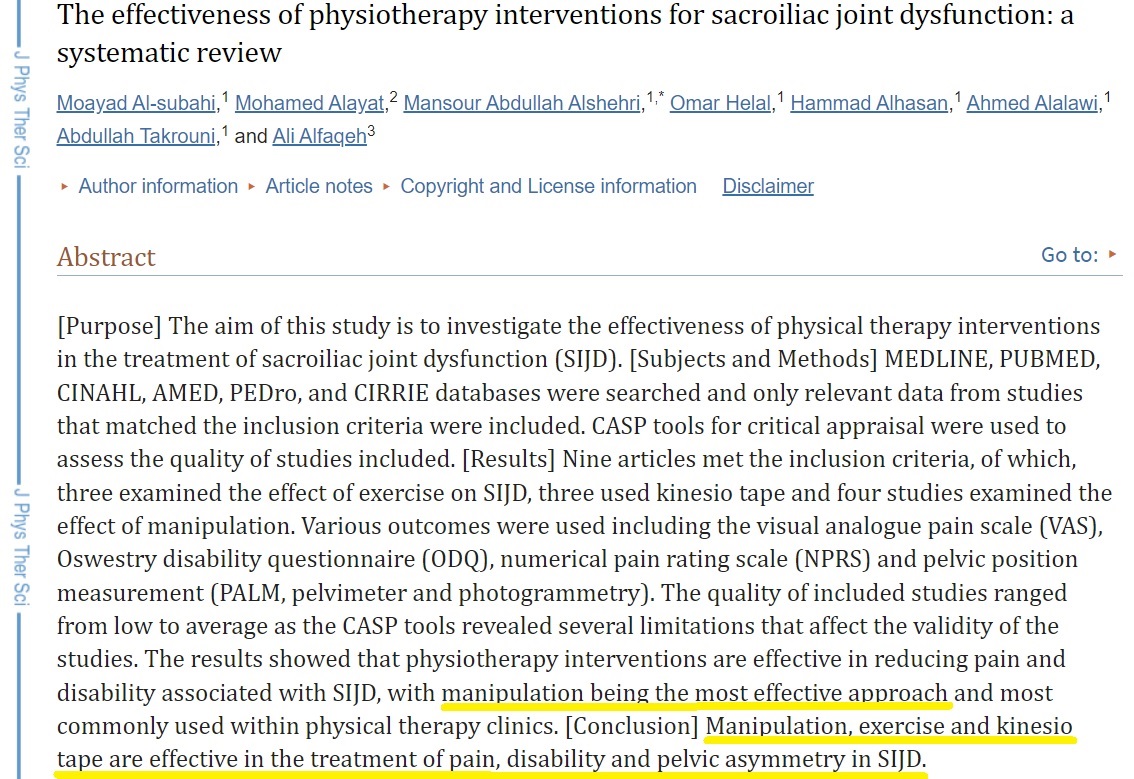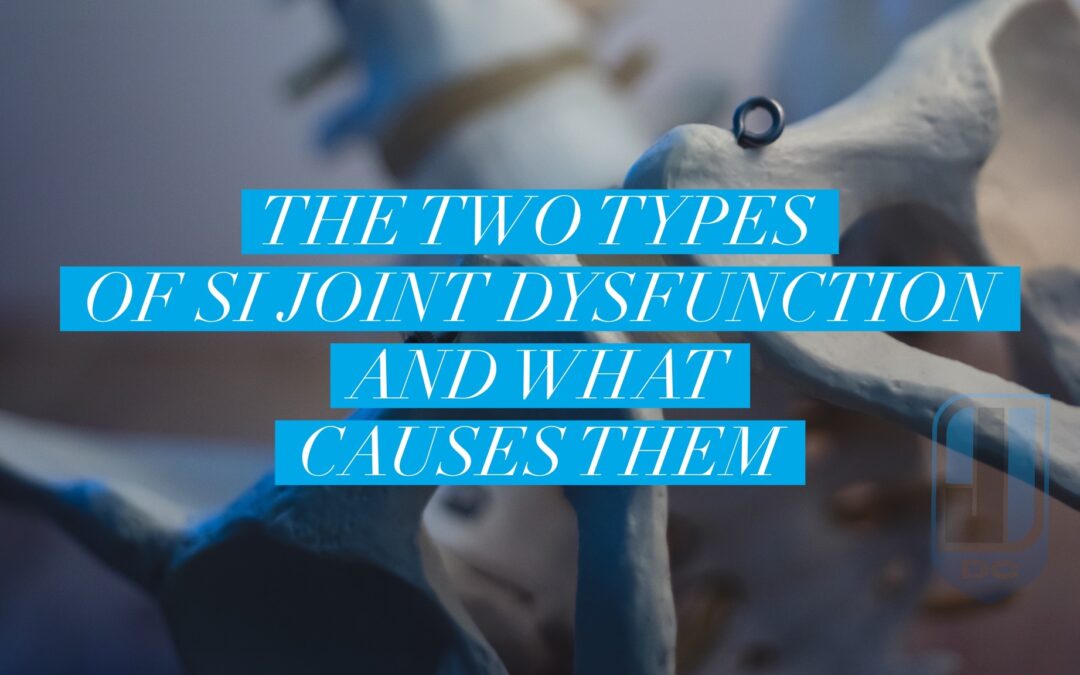Understanding the two types of SI joint dysfunction and what causes them can go a long way at helping you find the right treatments to relieve it. Most people and even some doctors who treat SI joint dysfunction aren’t aware that there are two types. Additionally, there are many different factors that can cause you to develop SI joint dysfunction so I’ll dive into those as well, but first let me give a quick description of the condition.
What is SI Joint Dysfunction?
SI joint dysfunction is a condition that causes pain in one or both of your SI joints. The SI joint, short for sacroiliac joint, is a joint formed between the sacrum and the ilium bones of the pelvis. You have two SI joints, one on each side of your lower back. They’re easy to find, just put your hands on your hips and feel the hard bones poking out, that’s them.
This painful condition can also refer to pain to your buttocks, thigh, groin, or lower leg in addition to pain in the joint itself. Research shows that up to 30% of low back pain may involve the SI joint. Since the SI joint is such a large joint, your symptoms may change based on what region of the joint is affected.
If the upper portion of the SI joint is affected, pain is typically felt local to the upper part of the joint. Pain in your middle of the buttocks is typically caused by issues in the middle portion of the SI joint. Pain in your lower buttocks is often caused by irritation of the lower portion of the SI joint.

Chiropractic Adjustments for SI Joint Pain
Chiropractic adjustments are both effective and safe treatment for SI joint pain caused by SI joint dysfunction. Treating SI joint dysfunction with chiropractic adjustments, exercises, and other therapies that chiropractors provide can relieve your pain and get you moving normally again. You can read about how manipulation (chiropractic adjustments) helps SI joint dysfunction here!
Types of SI Joint Dysfunction
There are two types of SI joint dysfunction you can have: Mechanical and Arthritic. I’ll dig into the two type of SI joint dysfunction and what causes them below.
Mechanical SI Joint Dysfunction
Mechanical SI joint dysfunction is caused by abnormal joint mechanics of your SI joint. This means either hypomobility (lack of normal motion) or hypermobility (excess motion) of the joint. It’s well known that your SI joint doesn’t move a whole lot, but despite this, when it loses its ability to move adequately or correctly it can create pain and functional difficulties.
What causes abnormal joint mechanics of your SI joint? You may be able to identify a previous injury, position or movement but many times it’s difficult to do this. Here are a few things I usually look for in my patients with mechanical SI joint dysfunction that may be causing the pain:
- Significant differences in leg length. This is often due to joint space loss or childhood injuries that affected a growth plate.
- Abnormal gait caused by other underlying issues like other injuries or conditions of the foot.
- Joint pain in the ankle, knee, or hip related to osteoarthritis or previous injuries you never completely recovered from.
- Scoliosis, which is a curvature of the spine that’s most frequently something you’re born with. Even subclinical (under 20 degree spine curves) may change the pelvis position and result in SI joint dysfunction.
- Previous low back surgery, like a lumbar fusion, which stabilizes two vertebrae together. This subsequently changes how the areas above and below the fusion move.
- Repetitive strenuous activities may cause your body to adapt in a way that’s not advantageous for the SI joint.
- Dysfunction in the muscles of your low back or pelvis. These can be caused by muscle belly and tendon injuries that never recovered completely.
- Previous traumatic injuries to the low back or pelvis that cause you to move differently and develop into chronic pain.
- Variants in your sacrum or pelvis, such as spina bifida occulta. Your pelvis may be a little different in form and move different compared to the average person.
Do You Have The Mechanical Type?
You may look at the above list and see a few things that apply to your individual case. Take it with a grain of salt, however. Just because you check a few of the boxes above doesn’t mean you have mechanical SI joint dysfunction or will develop it. For example, many people have had low back or pelvis injuries. Not all of them are going to develop SI joint dysfunction.
You may also look at the list and see that really none of those predisposing factors apply to you, or you may not be sure. Sometimes mechanical SI joint dysfunction may develop for no apparent reason. On the flip side, studies show that over half of cases of mechanical SI joint dysfunction develop from an injury.
Mechanical SI Joint Syndrome During Pregnancy
Pregnancy, unfortunately, is a major factor in the development of mechanical SI joint dysfunction in many women. At no other time in a woman’s life do you experience as much physical change so quickly as you do while pregnant. These changes can create the perfect storm for the development of mechanical SI joint dysfunction. These changes include:
- Weight gain
- Changes in how you walk
- Postural stresses
- Pregnancy-related ligament laxity
SI joint syndrome affects quite a few women while pregnant and can be difficult to manage. Chiropractic care for SI joint pain during pregnancy can be a very safe and effective strategy for you to use during this time. The main focus is managing pain and stabilizing the SI joint until your baby is born and your body can recover.
Arthritic SI Joint Dysfunction
Arthritic SI joint dysfunction is caused by, you guessed it, arthritis within the SI joint. There are a variety of arthritis types, however, the arthritis that most commonly affects the SI joint is osteoarthritis.
Osteoarthritis is most simply, “wear and tear” to your joints and the bones, ligaments, cartilage, and capsules that form them. Unfortunately osteoarthritis is something that will affect everyone as they age to various extents. Osteoarthritis in the SI joints may be more progressed if you have previous injuries to the joint, among other factors.
Arthritic Type Can Be Caused By Inflammatory Arthritis
Osteoarthritis in the SI joint is the most common cause of arthritis SI joint dysfunction, but there are other types of arthritis than cause it. Inflammatory types of arthritis are more severe types of arthritis caused by an autoimmune response in your body. The SI joint is one of the favorite spots for inflammatory arthritis to attack. Inflammatory arthritis often causes a condition called sacroiliitis, which then results in SI joint dysfunction as a secondary condition. Types of inflammatory arthritis that can affect your SI joint include:
- Ankylosing spondylitis (sometimes called AS or “bamboo spine.”)
- Psoriatic arthritis
- Enteropathic arthritis
- Reactive arthritis (sometimes called Reiter’s Syndrome.”)
A hallmark symptom of arthritic SI joint dysfunction (either osteoarthritis or inflammatory arthritis) is SI pain in the morning that lasts longer than 30 minutes and resolves with exercise or movement. Now you can recognize the two types of SI joint dysfunction and what causes them. Unfortunately, some folks will have signs and symptoms of both mechanical SI joint dysfunction as well as arthritic SI joint dysfunction.

Jason Williams DC is a licensed Doctor of Chiropractic with Physical Therapy Modality and Acupuncture privileges. He is a chiropractor in Dumfries, VA at Sentara Therapy Center. Dr. Williams’ clinical expertise is in the evaluation, treatment, and rehabilitation of neuro-musculoskeletal conditions. Specific focuses include spinal, extremity, and sports-related complaints. He brings a patient-first attitude to his treatments and is a proponent of evidence-based and integrative care. See more content and his contact info here.
The opinions and views are mine personally, and do not necessarily reflect the views of others in the profession, my employer, or organizations that I belong to.

